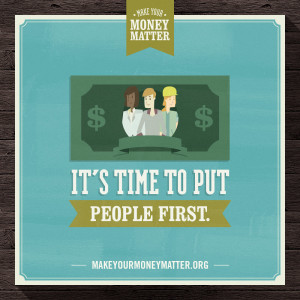**Full Disclosure: This post is sponsored by Make Your Money Matter, in association with PSCU, though all views expressed are my own.
Thanks for stopping by! If you like what you see, please follow me on Pinterest!
About:
“Make Your Money Matter” is a grassroots campaign introduced by eight credit unions from across the country and PSCU that aims to educate a new generation of consumers about the wealth of benefits credit unions provide over big banks.
“The impetus for this joint campaign came from the fact that credit unions offer all the products and conveniences you’d expect from a big bank, but unlike those big banks, credit unions are built around strengthening communities by providing low-interest loans and giving all their profit back to members, truly ‘making your money matter,’” said Fredda McDonald, Executive Vice President, PSCU, a leading provider of traditional and online financial services to credit unions. “With membership, the money you deposit stays in the community – your dollar could become somebody’s college degree or a loan for a family’s first home – and it’s these types of re-investments that draw local-minded consumers intent on consumption that keeps communities growing.”
Credit Unions vs. Banks
Credit unions are not-for-profit cooperatives that exist solely to provide financial services to their members, and anyone can find one that he or she is eligible to join. Unlike banks, it’s the members, not corporate shareholders, who own the credit unions. That means all the profit that credit unions bring in goes back to members in the form of dividends, rebates and lowered interest rates; for every $100 deposited at a credit union, on average $67 is directly redeployed to individual borrowers within the membership.
Services provided by credit unions mirror those of big banks, but that’s where the similarities end. On average, credit unions offer lower interest rates on loans and higher interest returns on investments, as well as lower fees for checking accounts, ATM surcharges, overdrafts and stopped payments.
Other benefits of credit unions include:
- Convenience: There are 5,000 shared branches in the credit union network and 100,000 ATMs in the shared ATM network. In addition, 1,182 credit unions participate in shared branching networks.
- Membership Impact: In the last year, credit unions distributed more than $5.3 billion in member dividends and refunds on loan interest payments. Additionally, 2.4 million credit union members have obtained vital credit since 2007 when for-profit lenders pulled back during the same time period. Credit unions enabled a total of 43,800 members to refinance “bad” debt within the last year. And in that same span, credit unions helped more than 37,000 families attain higher education access with fair value private student loan financing.
- Community Impact: More than 3.7 million Americans have joined a credit union since the end of September 2011. Credit unions helped 786,000 members by extending more than $134 billion of mortgage financing credit in the last year. Some 1,224 credit unions offer financial literacy classes to help members make more informed financial decisions. And in the last year, credit unions provided more than $630 million within local communities for building infrastructure to support new commercial, residential, industrial and farm-related developments.
Do You Know Where Your Money Really Goes?
When you use a big bank, do you know where your money really goes? Up to 97% of the money you deposit can leave the community and all of the profits stay with the shareholders, while you get stuck with the fees. But when you use a credit union, the money you deposit stays in the community. Your dollar can become someone’s college degree or a loan for a family’s first home. These local reinvestments are the seeds that keep communities growing.
Let’s invest in something that’s even bigger than the banks. Each other. Make your money matter. Join a credit union today!
Visit MakeYourMoneyMatter.org to learn more.



Leave a Reply